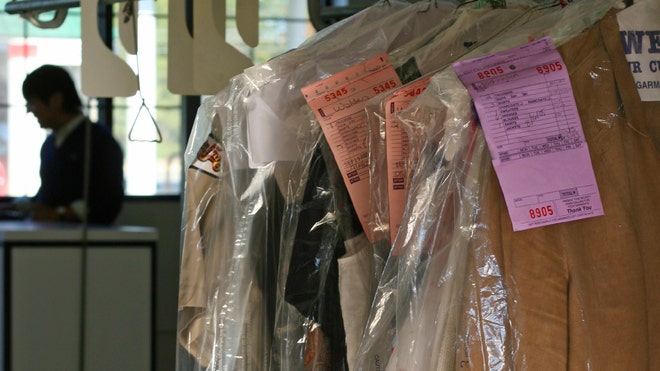Number of chemicals linked to autism and other disorders doubled in past 7 years, study shows
Source Amanda Woerner-
Fox

A
chemical commonly used in dry cleaning was included in a new list of
neurointoxicants known to cause problems in children.
The number of industrial chemicals with
known links to neurodevelopmental disabilities like autism has more than
doubled in the past seven years, according to new research published in The Lancet Neurology.
As rates of autism and attention
deficit-hyperactivity disorder (ADHD) increase worldwide, researchers believe
widespread exposure to these chemicals among children may be contributing to a
“silent epidemic” of people with neurodevelopmental disabilities.
Based on an analysis of previous studies,
researchers added six new toxins to a list of chemicals believed to pose a
threat to the brains of fetuses and young children: manganese, fluoride,
chlorpyrifos, dichlorodiphenyl-trichloroethane (DDT), tetrachloroethylene, and
the polybrominated diphenyl ethers.
While chemicals like manganese and fluoride,
common in drinking water, are rarely found in high enough concentrations in the
U.S. to pose a health threat, other chemicals on the list are much more
pervasive.
“Chlorpyrifos is an organic pesticide … 10
years ago it was banned for household use, but it is still extensively used in
agriculture and can be found in lots of fruits and vegetables,” study co-author
Dr. Philip Landrigan, of the Icahn School of Medicine at Mount Sinai in New
York City, told FoxNews.com.
And the list gets scarier:
Tetrachloroethylene, which has been linked to deficient neurological function
and increased risk of psychiatric diagnosis, is a common solvent used in dry
cleaning. Another chemical on the list, polybrominated diphenyl ethers, is a
type of flame retardant frequently found in couches. And while the pesticide
DDT is now banned in the U.S. due to human health risks, it’s still found in
imported fruits and vegetables, as well as in soil and water throughout the
country.
These six chemicals have been added to a
list of five other neurointoxicants – lead, methylmercury, polychlorinated
biphenyls, arsenic, and toluene – first identified by Landrigan and his
co-author, Dr. Phillipe Grandjean of the Harvard School of Public Health, in
2006.
How chemicals harm the
developing brain
Industrial chemicals pose a far greater threat to the neurological health of a developing fetuses, infants and young children than to adults, Landrigan noted.
Industrial chemicals pose a far greater threat to the neurological health of a developing fetuses, infants and young children than to adults, Landrigan noted.
During the early weeks of pregnancy, an
embryo forms the cells that eventually go on to become the brain and spinal
cord. Those cells divide, multiply and migrate, forming millions or even
billions of connections with surrounding cells – and build up the pathways that
form the body’s central nervous system.
“If some chemical gets in to the developing
brain, whether lead or methylmercury, and either kills brain cells or disrupts
cell division or cell migration, those connections are lost and the brain is
not as complete as it should have been,” Landrigan said. “And the consequence is
a child whose intelligence is reduced and attention span shortened, etc. The
human brain is a wondrous creation, and extremely complex, but the price of
that complexity is vulnerability.”
Though the researchers acknowledge that
increasing rates of conditions like ADHD and autism are partially due to
increased awareness about these conditions, they argue that other factors are
also at play.
“We note the increase of later diagnoses of
these disorders tracks very nicely with increased production and release into
environment of synthetic chemicals over last 40 or 50 years,” Landrigan said.
“And then on top of that, there’s the direct evidence we present in [the] paper
showing these particular chemicals have been linked to these problems in
children.”
How to curb the effects of
industrial toxins
Currently, the United States has no system by which to screen the potential health effects of industrial chemicals before they enter the marketplace – a problem which must change in order to reduce the levels of dangerous toxins in the environment, according to Landrigan.
Currently, the United States has no system by which to screen the potential health effects of industrial chemicals before they enter the marketplace – a problem which must change in order to reduce the levels of dangerous toxins in the environment, according to Landrigan.
“That’s the first thing, calling for proper
chemical testing,” Landrigan said. “There is bipartisan legislation currently
in Congress introduced by the late Senator Lautenberg and Senator (David)
Vitter and they said, ‘This is a nonpartisan issue, we all have children, we
should do something about it,’ and it’s currently being debated.”
Secondly, Landrigan and Grandjean propose
setting up an international agency dedicated to studying the toxicity of
chemicals, similar to organizations like the International Agency for Research
on Cancer. Landrigan said he believes efforts like these could slowly curb
increasing rates of autism and other neurodevelopmental disorders in the United
States.
“The short answer is yes [it could curb
rates of autism and other disorders], and the longer answer is it would take
time,” Landrigan said. “These chemicals are out there, some of them are quite
persistent. They aren’t going to disappear overnight, but I think it’s
entirely worthwhile for the government to take action.”
However, concerned parents can also take
action to reduce exposure in simpler ways – for example, by eating organic or
eliminating wall-to-wall carpeting in homes, which can trap chemicals and
pesticides.
“Lastly, I talk with parents about what to
buy and even in the case of chemicals where evidence for toxicity is not yet
solid, like phthalates and BPA, it makes sense to buy products free of
chemicals,” Landrigan said. “I say to people, ‘Why take a chance? Why risk your
health and your child’s health with exposure to a chemical [with] at least some
toxicity when there are safe alternatives available?
see www.gooddeedsmall.com
No comments:
Post a Comment